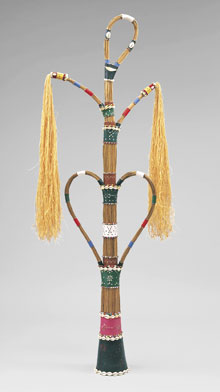
Mestre Didi, Iwin Igi (Ancestral Spirit of the Tree), 1999. Bundled palm ribs, leather, beads, and cowrie shells, 190 x 60 cm. Collection of the artist. Photo by Fernando Chaves.

The role played by Africa in the formation of the Brazilian collective consciousness cannot be overstated. From the earliest contacts between the New and the Old Worlds, cultural patterns have developed in Brazil that parallel those of many of the African civilizations from which slaves were taken. Food, language, visual art, music, and dance are all elements of Brazilian culture that have been permeated and enriched by contributions from Africa. Some of the greatest masters of the Baroque period, such as O Aleijadinho (Antônio Francisco Lisboa) and Mestre Valentim, were of African descent.
Brazilian art historian Marta Heloísa Leuba Salum has stated that “Afro-Brazilian art is a contemporary phenomenon . . . encompassing any expression in the visual arts that recaptures, on one hand, traditional African aesthetics and religiosity and, on the other, the sociocultural contexts of blacks in Brazil.” The art of Mestre Didi is a key link in understanding the phenomenon of Afro-Brazilian art. His ritual scepters and other pieces, fashioned from palm ribs, leather, shells, and other materials connect the manifestations of the Yoruba spirits with allusions to ancient myths of creation. Works by Agnaldo Manoel dos Santos, GTO (Geraldo Teles de Oliveira), and Maurino Araújo, which share a common style and spirit, are equally redolent of African inspiration. Rubem Valentim created two- and three-dimensional totemic figures that appropriate the Constructivist vocabulary of the Concrete movement. Ronaldo Rêgo, a priest in the Umbanda religion (which combines elements of Bantu and Christian worship), creates works that suggest sacred rituals.
—Edward J. Sullivan